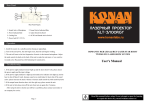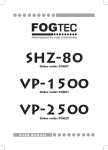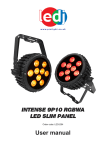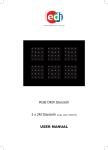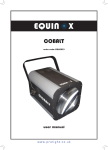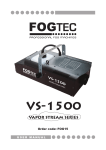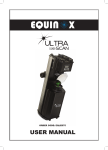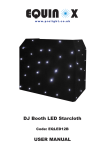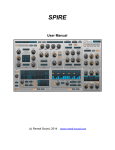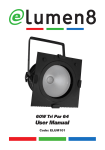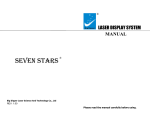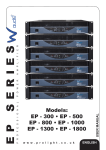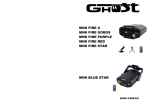Download LS-FBTRI RGB Laser DMX
Transcript
LS-FBTRI RGB Laser DMX 152.903 Instruction Manual Safety WARNING FOR YOUR OWN SAFETY, PLEASE READ THIS USER MANUAL BEFORE YOUR INITIAL START-UP! CAREFULLY CAUTION! Keep this equipment away from rain, moisture and liquids. SAFETY INSTRUCTIONS Every person involved with the installation, operation & maintenance of this equipment should: Be competent Follow the instructions of this manual CAUTION! TAKE CARE USING THIS EQUIPMENT! HIGH VOLTAGE-RISK OF ELECTRIC SHOCK!! Before your initial start-up, please make sure that there is no damage caused during transportation. Should there be any, consult your dealer and do not use the equipment. To maintain the equipment in good working condition and to ensure safe operation, it is necessary for the user to follow the safety instructions and warning notes written in this manual. Please note that damages caused by user modifications to this equipment are not subject to warranty. Safety IMPORTANT: The manufacturer will not accept liability for any resulting damages caused by the non-observance of this manual or any unauthorized modification to the equipment. • Never let the power-cable come into contact with other cables. Handle the power-cable and all mains voltage connections with particular caution! • Never remove warning or informative labels from the equipment. • Do not open the equipment and do not modify the equipment. • Do not connect this equipment to a dimmer-pack. • Do not switch the equipment on and off in short intervals, as this will reduce the system’s life. • Only use the equipment indoors. • Do not expose to flammable sources, liquids or gases. • Always disconnect the power from the mains when equipment is not in use or before cleaning! Only handle the power-cable by the plug. Never pull out the plug by pulling the power-cable. • Make sure that the available voltage is between 220v/240v. • Make sure that the power-cable is never crimped or damaged. Check the equipment and the power-cable periodically. • If the equipment is dropped or damaged, disconnect the mains power supply immediately. Have a qualified engineer inspect the equipment before operating again. • If the equipment has been exposed to drastic temperature fluctuation (e.g. after transportation), do not switch it on immediately. The arising condensation might damage the equipment. Leave the equipment switched off until it has reached room temperature. • If your product fails to function correctly, discontinue use immediately. Pack the unit securely (preferably in the original packing material), and return it to your Prolight dealer for service. • Only use fuses of same type and rating. • Repairs, servicing and power connection must only be carried out by a qualified technician. THIS UNIT CONTAINS NO USER SERVICEABLE PARTS. • WARRANTY; One year from date of purchase. OPERATING DETERMINATIONS If this equipment is operated in any other way, than those described in this manual, the product may suffer damage and the warranty becomes void. Incorrect operation may lead to danger e.g.: short-circuit, burns, electric shocks, lamp failure etc. Do not endanger your own safety and the safety of others! Incorrect installation or use can cause serious damage to people and property. Technical specifications You should find inside the Laser carton the following items: 1, Trinity Beam Laser 2, Power cable 3, User manual 4, Safety Keys Technical Specifications: DMX channels: 2 Laser diodes: 1 x 80mW Green (532nM) DPSS laser, 1 x 400mW Blue (450nM) DPSS laser 1 x 300mW Red (650nM) DPSS laser Operating modes: 1, Sound Active 2, Auto Run 3, DMX 4, Master/slave Power consumption: 220W Power supply: 240V - 50Hz Dimensions: 350 x 392 x 110mm Weight: 4.6Kgs Fuse: 2A Features: The Beam Laser features 7 DMX channels and many laser patterns that are ideal with or without fog. Back view: Hanging bracket positioning: When you first open the carton, you will notice that the hanging bracket is placed on back of the unit, this is for installation set up. Installation set up Operation modes: The Beam laser has 4 modes of operation as follows: 1, Sound active mode To select sound active mode set dip switch 10 to ON and all others to OFF. You can now use the sensitivity control on the back panel to set the required sound level. 2, Auto run mode To select auto pattern mode, set dip switch 9 and 10 to the ON position and all others to OFF. The Trinity Beam will now cycle through all it’s internal patterns. 3, DMX mode To select DMX mode, set dip switch 10 to OFF. You can now set the required DMX address using dip switches 1 to 9. Please refer to the chart below for DMX functions. The DMX address starts at 1. 4, Master/slave mode To set the unit/s in slave mode, set dip switch 3 to the ON position and all others to OFF. The Trinity Beam laser/s will now run in sequence with the master unit. Example: DMX function chart: Channel CH.1 CH.2 DMX Address Function 0-70 Blackout 71-140 Sound active 141-210 Auto run 211-255 DMX manual mode 0-255 28 Pattern selector (CH.1, DMX manual mode) DMX control mode DMX Control Mode Operating in a DMX control mode environment gives the user the greatest flexibility when it comes to customising or creating a show. In this mode you will be able to control each individual trait of the fixture and each fixture independently. Setting the DMX address The DMX mode enables the use of a universal DMX controller. Each fixture requires a “start address” from 1- 511. A fixture requiring one or more channels for control begins to read the data on the channel indicated by the start address. For example, a fixture that occupies or uses 7 channels of DMX and was addressed to start on DMX channel 100, would read data from channels: 100,101,102,103,104,105 and 106. Choose a start address so that the channels used do not overlap. E.g. the next unit in the chain starts at 107. Set the start address using the group of dip switches located usually on the back of the fixture. Each dip switch has an associated value. Adding the value of each switch in the ON position will provide the start address. Determining which switches to toggle ON given a specific start address can be accomplished in the following manner. By subtracting the largest switch value possible from the selected start address until zero is achieved. EXAMPLE STARTING ADDRESS on Address 10 Pin NO: 4 = 8 Pin NO: 2 = 2 Total = 10 on Address 24 Pin NO: 5 = 16 Pin NO: 4 = 8 Total = 24 DMX address using simple maths 233 - (128 = 105, Turn on dip No: 8 105 - (64) = 41, Turn on dip No:7 41 - (32) = 9, Turn on dip No: 6 9 - (8) = 1, Turn on dip No: 4 1 - (1) = 0, Turn on dip No:1 You will most likely use the first available number which maybe Number 1. This number was selected for example purposes DIP SWITCH 1 2 3 4 5 6 7 8 9 10 (DMX VALUE) 1 2 4 8 16 32 64 128 256 DMX Set Up DMX-512: • DMX (Digital Multiplex) is a universal protocol used as a form of communication between intelligent fixtures and controllers. A DMX controller sends DMX data instructions form the controller to the fixture. DMX data is sent as serial data that travels from fixture to fixture via the DATA “IN” and DATA “OUT” XLR terminals located on all DMX fixtures (most controllers only have a data “out” terminal). DMX Linking: • DMX is a language allowing all makes and models of different manufactures to be linked together and operate from a single controller, as long as all fixtures and the controller are DMX compliant. To ensure proper DMX data transmission, when using several DMX fixtures try to use the shortest cable path possible. The order in which fixtures are connected in a DMX line does not influence the DMX addressing. For example; a fixture assigned to a DMX address of 1 may be placed anywhere in a DMX line, at the beginning, at the end, or anywhere in the middle. When a fixture is assigned a DMX address of 1, the DMX controller knows to send DATA assigned to address 1 to that unit, no matter where it is located in the DMX chain. DATA Cable (DMX cable) requirements (for DMX operation): • The Beam laser can be controlled via DMX-512 protocol. The DMX address is set on the back of the unit. Your unit and your DMX controller require a standard 3-pin XLR connector for data input/output (figure 1). Figure 1 Also remember that DMX cable must be daisy chained and cannot be split. Notice: DMX Set Up • Be sure to follow figures 2 & 3 when making your own cables. Do not connect the cable’s shield conductor to the ground lug or allow the shield conductor to come in contact with the XLR’s outer casing. Grounding the shield could cause a short circuit and erratic behaviour. Special Note: Line termination: • When longer runs of cable are used, you may need to use a terminator on the last unit to avoid erratic behaviour. Termination reduces signal transmission problems and interferance. it is always advisable to connect a DMX terminal, (resistance 120 Ohm 1/4 W) between pin 2 (DMX-) and pin 3 (DMX+) of the last fixture. Using a cable terminator (part number CABL90) will decrease the possibilities of erratic behaviour. 5-Pin XLR DMX Connectors: • Some manufactures use 5-pin XLR connectors for data transmission in place of 3-pin. 5-Pin XLR fixtures may be implemented in a 3-pin XLR DMX line. When inserting standard 5-pin XLR connectors in to a 3-pin line a cable adaptor must be used. The Chart below details the correct cable conversion. DMX Dip Switch Quick Reference Chart Dip Switch Position










